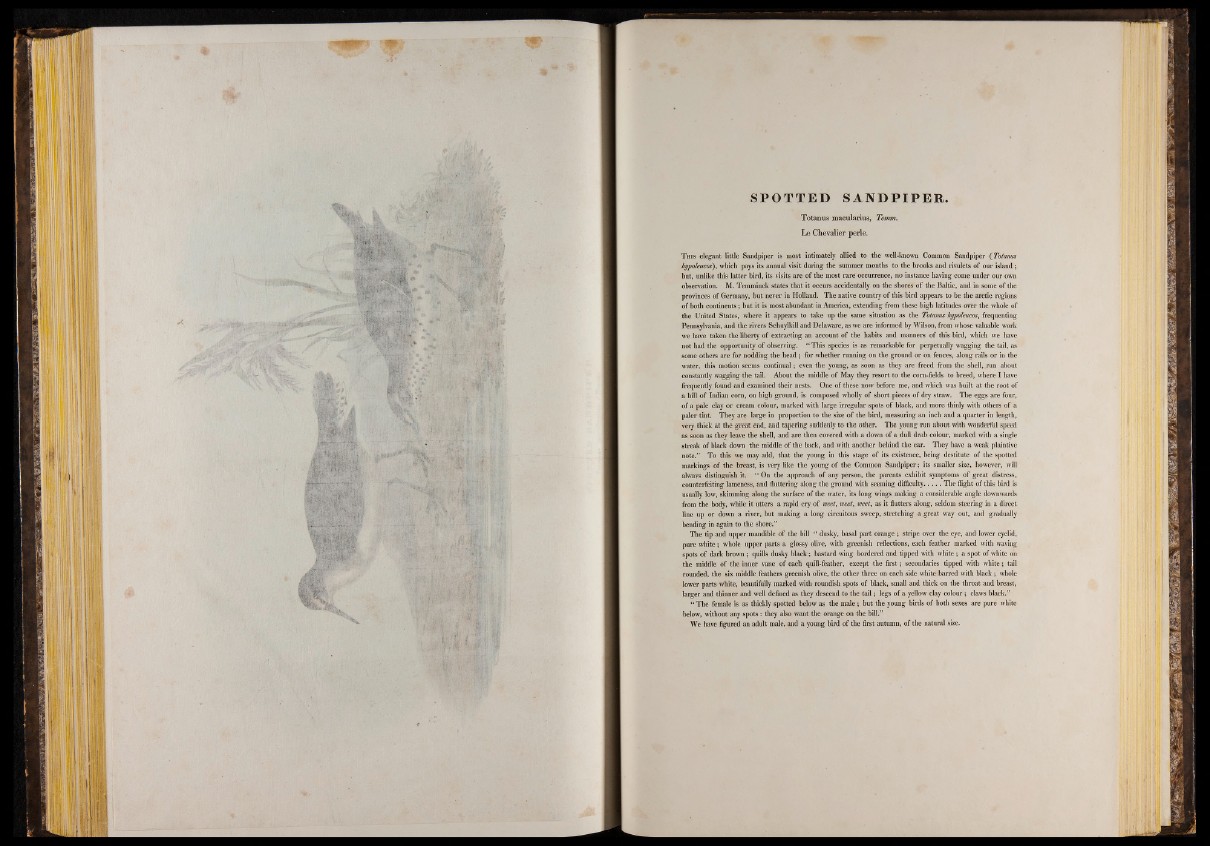
SPOTTED SANDPIPER.
T o tan u s macularius, Temm.
Le Chevalier perle.
T h is elegant little Sandpiper is most intimately allied to the well-known Common Sandpiper ( Totanus
hypoleucos) , which pays its annual visit during the summer months to the brooks and rivulets of our island;
but, unlike this latter bird, its visits are o f the most rare occurrence, no instance having come under our own
observation. M. Temminck states that it occurs accidentally on the shores o f the Baltic, and in some of the
provinces o f Germany, but never in Holland. The native country o f this bird appears to be the arctic regions
of both continents; but it is most abundant in America, extending from these high latitudes over the whole of
the United States, where it appears to take up the same situation as the Totanus hypoleucos, frequenting
Pennsylvania, and the rivers Schuylkill and Delaware, as we are informed by Wilson, from whose valuable work
we have taken the liberty o f extracting an account o f the habits and manners o f this bird, which we have
not had the opportunity o f observing. “ This species is as remarkable for perpetually wagging the tail, as
some others are for nodding the head ; for whether running on the ground or on fences, along rails or in the
water, this motion seems continual; even the young, as soon as they are freed from the shell, ,run about
constantly wagging the tail. About the middle of May they resort to the corn-fields to breed, where I have
frequently , found and examined their nests. One o f these now before me, and which was built at the root of
a hill of Indian corn, on high ground, is composed wholly o f short pieces o f dry straw. The eggs are four,
o f a pale clay or cream colour, marked with large irregular spots o f black, and more thinly with others o f a
paler tint. They are large in proportion to the size of the bird, measuring an inch and a quarter in length,
very thick at the great end, and tapering suddenly to the other. The young run about with wonderful speed
as soon as they leave the shell, and are then covered with a down o f a dull drab colour, marked with a single
streak o f black down the middle o f the back, and with another behind the ear. They have a weak plaintive
note.” To this we may add, that the young in this stage o f its existence, being destitute o f the spotted
markings o f the breast, is very like the young o f the Common Sandpiper; its smaller size, however, will
always distinguish it. “ On the approach o f any person, the parents exhibit symptoms o f great distress,
counterfeiting lameness, and fluttering along the ground with seeming difficulty The flight of this bird is
usually low, skimming along the surface o f the water, its long wings making a considerable angle downwards
from the body, while it utters a rapid cry o f meet, weet, weet, as it flutters along, seldom steering in a direct
line up or down a river, but making a long circuitous sweep, stretching a great way out, and gradually
bending in again to the shore.”
The tip and upper mandible o f the bill “ dusky, basal part orange ; stripe over the eye, and lower eyelid,
pure white; whole upper parts a glossy olive, with greenish reflections, each feather marked with waving
spots of dark brown ; quills dusky black; bastard wing bordered and tipped with white ; a spot of white on
the middle o f the inner vane o f each quill-feather, except the first; secondaries tipped with white; tail
rounded, the six middle feathers greenish olive, the other three on each side white barred with black; whole
lower parts white, beautifully marked with roundish spots o f black, small and thick on the throat and breast,
larger and thinner and well defined as they descend to the ta il; legs o f a yellow clay colour; claws black.”
“ The female is as thickly spotted below as the male; but the young birds o f both sexes are pure white
below, without any spots: they also want the orange on the bill.”
We have figured an adult male, and a young bird o f the first autumn, o f the natural size.